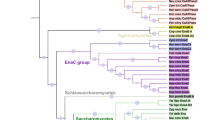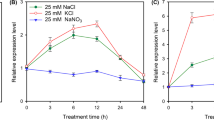Abstract
Potassium accumulation is an essential aspect of bacterial response to diverse stress situations; consequently its uptake plays a pivotal role. Here, we show that the Gram-positive soil bacterium Corynebacterium glutamicum which is employed for the large-scale industrial production of amino acids requires potassium under conditions of ionic and non-ionic osmotic stress. Besides the accumulation of high concentrations of potassium contributing significantly to the osmotic potential of the cytoplasm, we demonstrate that glutamate is not the counter ion for potassium under these conditions. Interestingly, potassium is required for the activation of osmotic stress-dependent expression of the genes betP and proP. The Kup-type potassium transport system which is present in C. glutamicum in addition to the potassium channel CglK does not contribute to potassium uptake at conditions of hyperosmotic stress. Furthermore, we established a secondary carrier of the KtrAB type from C. jeikeium in C. glutamicum thus providing an experimental comparison of channel- and carrier-mediated potassium uptake under osmotic stress. While at low potassium availability, the presence of the KtrAB transporter improves both potassium accumulation and growth of C. glutamicum upon osmotic stress, at proper potassium supply, the channel CglK is sufficient.






Similar content being viewed by others
References
Abe S, Takayama K, Kinoshita S (1967) Taxonomical studies on glutamic acid-producing bacteria. J Gen Microbiol 13:279–301
Berry S, Esper B, Karandashova I, Teuber M, Elanskaya I, Rögner M, Hagemann M (2003) Potassium uptake in the unicellular cyanobacterium Synechocystis sp. strain PCC 6803 mainly depends on a Ktr-like system encoded by slr1509 (ntpJ). FEBS Lett 548(1–3):53–58
Booth IR (1985) Regulation of cytoplasmic pH in bacteria. Microbiol Rev 49(4):359–378
Bremer E, Krämer R (2000) Coping with osmotic challenges. In: Storz G, Hengge-Aronis R (eds) Bacterial stress responses. ASM Press, Washington, pp 79–97
Brown AD (1976) Microbial water stress. Bacteriol Rev 40:803–846
Cao Y, Jin X, Huang H, Derebe MG, Levin EJ, Kabaleeswaran V, Pan Y, Punta M, Love J, Weng J, Quick M, Ye S, Kloss B, Bruni R, Martinez-Hackert E, Hendrickson WA, Rost B, Javitch JA, Rajashankar KR, Jiang Y, Zhou M (2011) Crystal structure of a potassium ion transporter, TrkH. Nature 471(7338):336–340
Dinnbier U, Limpinsel E, Schmid R, Bakker EP (1988) Transient accumulation of potassium glutamate and its replacement by trehalose during adaptation of growing cells of Escherichia coli K-12 to elevated sodium chloride concentrations. Arch Microbiol 150(4):348–357
Eikmanns BJ, Kleinertz E, Liebl W, Sahm H (1991) A family of Corynebacterium glutamicum/Escherichia coli shuttle vectors for cloning, controlled gene expression, and promoter probing. Gene 102(1):93–98
Epstein W (2003) The roles and regulation of potassium in bacteria. Prog Nucleic Acid Res Mol Biol 75:293–320
Farwick M, Siewe RM, Krämer R (1995) Glycine betaine uptake after hyperosmotic shift in Corynebacterium glutamicum. J Bacteriol 177(16):4690–4695
Follmann M, Becker M, Ochrombel I, Ott V, Krämer R, Marin K (2009) Potassium transport in corynebacterium glutamicum is facilitated by the putative channel protein CglK, which is essential for pH homeostasis and growth at acidic pH. J Bacteriol 191(9):2944–2952
Gralla JD, Vargas DR (2006) Potassium glutamate as a transcriptional inhibitor during bacterial osmoregulation. EMBO J 25(7):1515–1521
Grant SG, Jessee J, Bloom FR, Hanahan D (1990) Differential plasmid rescue from transgenic mouse DNAs into Escherichia coli methylation-restriction mutants. Proc Natl Acad Sci USA 87(12):4645–4649
Guillouet S, Engasser JM (1995) Sodium and proline accumulation in Corynebacterium glutamicum as a response to an osmotic saline upshock. Appl Microbiol Biotechnol 43(2):315–320
Guillouet S, Engasser JM (1996) Growth of Corynebacterium glutamicum in ammonium- and potassium-limited continuous cultures under high osmotic pressure. Appl Microbiol Biotechnol 46(3):291–296
Hincha DK, Hagemann M (2004) Stabilization of model membranes during drying by compatible solutes involved in the stress tolerance of plants and microorganisms. Biochem J 383(Pt 2):277–283
Holtmann G, Bakker EP, Uozumi N, Bremer E (2003) KtrAB and KtrCD: two K+ uptake systems in Bacillus subtilis and their role in adaptation to hypertonicity. J Bacteriol 185(4):1289–1298
Krämer R, Lambert C, Hoischen C, Ebbighausen H (1990) Uptake of glutamate in Corynebacterium glutamicum. 1. Kinetic properties and regulation by internal pH and potassium. Eur J Biochem 194(3):929–935
Kröning N, Willenborg M, Tholema N, Hänelt I, Schmid R, Bakker EP (2007) ATP binding to the KTN/RCK subunit KtrA from the K+-uptake system KtrAB of Vibrio alginolyticus: its role in the formation of the KtrAB complex and its requirement in vivo. J Biol Chem 282(19):14018–14027
Liu Y, Bolen DW (1995) The peptide backbone plays a dominant role in protein stabilization by naturally occurring osmolytes. Biochemistry 34:12884–12891
Matsuda N, Kobayashi H, Katoh H, Ogawa T, Futatsugi L, Nakamura T, Bakker EP, Uozumi N (2004) Na+-dependent K+ uptake Ktr system from the cyanobacterium Synechocystis sp. PCC 6803 and its role in the early phases of cell adaptation to hyperosmotic shock. J Biol Chem 279(52):54952–54962
McLaggan D, Naprstek J, Buurman ET, Epstein W (1994) Interdependence of K+ and glutamate accumulation during osmotic adaptation of Escherichia coli. J Biol Chem 269(3):1911–1917
Möker N, Brocker M, Schaffer S, Krämer R, Morbach S, Bott M (2004) Deletion of the genes encoding the MtrA-MtrB two-component system of Corynebacterium glutamicum has a strong influence on cell morphology, antibiotics susceptibility and expression of genes involved in osmoprotection. Mol Microbiol 54(2):420–438
Möker N, Krämer J, Unden G, Krämer R, Morbach S (2007a) In vitro analysis of the two-component system MtrB-MtrA from Corynebacterium glutamicum. J Bacteriol 189(9):3645–3649
Möker N, Reihlen P, Krämer R, Morbach S (2007b) Osmosensing properties of the histidine protein kinase MtrB from Corynebacterium glutamicum. J Biol Chem 282(38):27666–27677
Nissen P, Hansen J, Ban N, Moore PB, Steitz TA (2000) The structural basis of ribosome activity in peptide bond synthesis. Science 289(5481):920–930
Ochrombel I, Ott L, Krämer R, Burkovski A, Marin K (2011) Impact of improved potassium accumulation on pH homeostasis, membrane potential adjustment and survival of Corynebacterium glutamicum. Biochim Biophys Acta 1807(4):444–450
Peter H, Weil B, Burkovski A, Krämer R, Morbach S (1998) Corynebacterium glutamicum is equipped with four secondary carriers for compatible solutes: identification, sequencing, and characterization of the proline/ectoine uptake system, ProP, and the ectoine/proline/glycine betaine carrier, EctP. J Bacteriol 180(22):6005–6012
Prabhakar V, Löttgert T, Geimer S, Dormann P, Krüger S, Vijayakumar V, Schreiber L, Gobel C, Feussner K, Feussner I, Marin K, Staehr P, Bell K, Flügge UI, Häusler RE (2010) Phosphoenolpyruvate provision to plastids is essential for gametophyte and sporophyte development in Arabidopsis thaliana. Plant Cell 22(8):2594–2617
Reed RH, Warr SRC, Richardson DL, Stewart WDP (1985) Multiphasic osmotic adjustment in a euryhaline cyanobacterium. FEMS Microbiol Lett 28:225–229
Roosild TP, Castronovo S, Miller S, Li C, Rasmussen T, Bartlett W, Gunasekera B, Choe S, Booth IR (2009) KTN (RCK) domains regulate K+ channels and transporters by controlling the dimer-hinge conformation. Structure 17(6):893–903
Rübenhagen R, Morbach S, Krämer R (2001) The osmoreactive betaine carrier BetP from Corynebacterium glutamicum is a sensor for cytoplasmic K+. EMBO J 20(19):5412–5420
Saum SH, Müller V (2008) Regulation of osmoadaptation in the moderate halophile Halobacillus halophilus: chloride, glutamate and switching osmolyte strategies. Saline Systems 4:4
Skjerdal OT, Sletta H, Flenstad SG, Josefsen KD, Levine DW, Ellingsen TE (1995) Changes in cell volume, growth and respiration rate in response to hyperosmotic stress of NaCl, sucrose and glutamic acid in Brevibacterium lactofermentum and Corynebacterium glutamicum. Appl Microbiol Biotechnol 43(6):1099–1106
Stingl K, Brandt S, Uhlemann EM, Schmid R, Altendorf K, Zeilinger C, Ecobichon C, Labigne A, Bakker EP, de Reuse H (2007) Channel-mediated potassium uptake in Helicobacter pylori is essential for gastric colonization. EMBO J 26(1):232–241
Stumpe S, Bakker EP (1997) Requirement of a large K+-uptake capacity and of extracytoplasmic protease activity for protamine resistance of Escherichia coli. Arch Microbiol 167(2/3):126–136
Thompson AN, Posson DJ, Parsa PV, Nimigean CM (2008) Molecular mechanism of pH sensing in KcsA potassium channels. Proc Natl Acad Sci USA 105(19):6900–6905
Trchounian A, Kobayashi H (1998) Relationship of K+-uptaking system with H+-translocating ATPase in Enterococcus hirae, grown at a high or low alkaline pH. Curr Microbiol 36(2):114–118
Trchounian A, Kobayashi H (1999) Kup is the major K+ uptake system in Escherichia coli upon hyper-osmotic stress at a low pH. FEBS Lett 447(2–3):144–148
Varela C, Agosin E, Baez M, Klapa M, Stephanopoulos G (2003) Metabolic flux redistribution in Corynebacterium glutamicum in response to osmotic stress. Appl Microbiol Biotechnol 60(5):547–555
Weinand M, Krämer R, Morbach S (2007) Characterization of compatible solute transporter multiplicity in Corynebacterium glutamicum. Appl Microbiol Biotechnol 76(3):701–708
Whatmore AM, Reed RH (1990) Determination of turgor pressure in Bacillus subtilis: a possible role for K+ in turgor regulation. J Gen Microbiol 136(12):2521–2526
Wood JM (1999) Osmosensing by bacteria: signals and membrane-based sensors. Microbiol Mol Biol Rev 63(1):230–262
Acknowledgments
We like to thank Ute Meyer for excellent technical assistance. R. K. and K. M. are supported by grants from the BMBF (SysMap: 0313704, SysEnCor: 0315598H).
Author information
Authors and Affiliations
Corresponding author
Additional information
Communicated by Erko Stackebrandt.
Electronic supplementary material
Below is the link to the electronic supplementary material.
Rights and permissions
About this article
Cite this article
Ochrombel, I., Becker, M., Krämer, R. et al. Osmotic stress response in C. glutamicum: impact of channel- and transporter-mediated potassium accumulation. Arch Microbiol 193, 787–796 (2011). https://doi.org/10.1007/s00203-011-0717-6
Received:
Revised:
Accepted:
Published:
Issue Date:
DOI: https://doi.org/10.1007/s00203-011-0717-6




